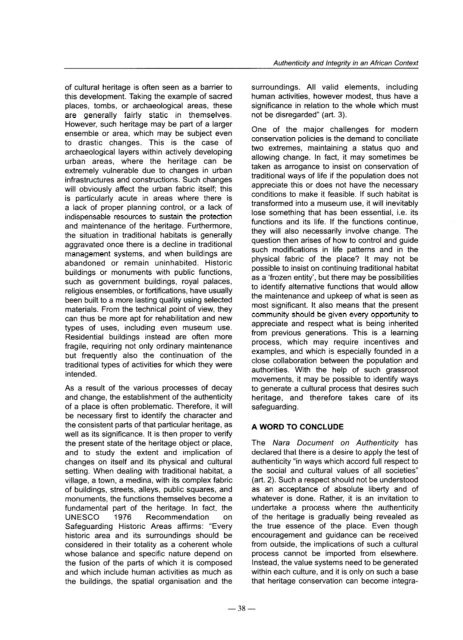Mul - unesdoc - Unesco
Mul - unesdoc - Unesco
Mul - unesdoc - Unesco
Create successful ePaper yourself
Turn your PDF publications into a flip-book with our unique Google optimized e-Paper software.
of cultural heritage is often seen as a barrier to<br />
this development. Taking the example of sacred<br />
places, tombs, or archaeological areas, these<br />
are generally fairly static in themselves.<br />
However, such heritage may be part of a larger<br />
ensemble or area, which may be subject even<br />
to drastic changes. This is the case of<br />
archaeological layers within actively developing<br />
urban areas, where the heritage cari be<br />
extremely vulnerable due to changes in urban<br />
infrastructures and constructions. Such changes<br />
Will obviously affect the urban fabric itself; this<br />
is particularly acute in areas where there is<br />
a lack of proper planning control, or a lack of<br />
indispensable resources to sustain the protection<br />
and maintenance of the heritage. Furthermore,<br />
the situation in traditional habitats is generally<br />
aggravated once there is a decline in traditional<br />
management systems, and when buildings are<br />
abandoned or remain uninhabited. Historic<br />
buildings or monuments with public functions,<br />
such as government buildings, royal palaces,<br />
religious ensembles, or fortifications, have usually<br />
been built to a more lasting quality using selected<br />
materials. From the technical point of view, they<br />
cari thus be more apt for rehabilitation and new<br />
types of uses, including even museum use.<br />
Residential buildings instead are often more<br />
fragile, requiring not only ordinary maintenance<br />
but frequently also the continuation of the<br />
traditional types of activities for which they were<br />
intended.<br />
As a result of the various processes of decay<br />
and change, the establishment of the authenticity<br />
of a place is often problematic. Therefore, it Will<br />
be necessary first to identify the character and<br />
the consistent parts of that particular heritage, as<br />
well as its significance. It is then proper to verify<br />
the present state of the heritage abject or place,<br />
and to study the extent and implication of<br />
changes on itself and its physical and cultural<br />
setting. When dealing with traditional habitat, a<br />
village, a town, a medina, with its complex fabric<br />
of buildings, streets, alleys, public squares, and<br />
monuments, the functions themselves become a<br />
fundamental part of the heritage. In fact, the<br />
UNESCO 1976 Recommendation on<br />
Safeguarding Historic Areas affirms: “Every<br />
historic area and its surroundings should be<br />
considered in their totality as a coherent whole<br />
whose balance and specific nature depend on<br />
the fusion of the parts of which it is composed<br />
and which include human activities as much as<br />
the buildings, the spatial organisation and the<br />
- 38 -<br />
Authenticity and Integrity in an African Context<br />
surroundings. All valid elements, including<br />
human activities, however modest, thus have a<br />
significance in relation to the whole which must<br />
not be disregarded” (art. 3).<br />
One of the major challenges for modern<br />
conservation policies is the demand to conciliate<br />
two extremes, maintaining a status quo and<br />
allowing change. In fact, it may sometimes be<br />
taken as arrogance to insist on conservation of<br />
traditional ways of life if the population does not<br />
appreciate this or does not have the necessary<br />
conditions to make it feasible. If such habitat is<br />
transformed into a museum use, it Will inevitably<br />
lose something that has been essential, i.e. its<br />
functions and its life. If the functions continue,<br />
they Will also necessarily involve change. The<br />
question then arises of how to control and guide<br />
such modifications in life patterns and in the<br />
physical fabric of the place? It may not be<br />
possible to insist on continuing traditional habitat<br />
as a ‘frozen entity’, but there may be possibilities<br />
to identify alternative functions that would allow<br />
the maintenance and upkeep of what is seen as<br />
most significant. It also means that the present<br />
community should be given every opportunity to<br />
appreciate and respect what is being inherited<br />
from previous generations. This is a learning<br />
process, which may require incentives and<br />
examples, and which is especially founded in a<br />
close collaboration between the population and<br />
authorities. With the help of such grassroot<br />
movements, it may be possible to identify ways<br />
to generate a cultural process that desires such<br />
heritage, and therefore takes tare of its<br />
safeguarding.<br />
A WORD TO CONCLUDE<br />
The Nara Document on Aufhenficify has<br />
declared that there is a desire to apply the test of<br />
authenticity “in ways which accord full respect to<br />
the social and cultural values of all societies”<br />
(art. 2). Such a respect should not be understood<br />
as an acceptance of absolute liberty and of<br />
whatever is done. Rather, it is an invitation to<br />
undertake a process where the authenticity<br />
of the heritage is gradually being revealed as<br />
the true essence of the place. Even though<br />
encouragement and guidance cari be received<br />
from outside, the implications of such a cultural<br />
process cannot be imported from elsewhere.<br />
Instead, the value systems need to be generated<br />
within each culture, and it is only on such a base<br />
that heritage conservation cari become integra-

















